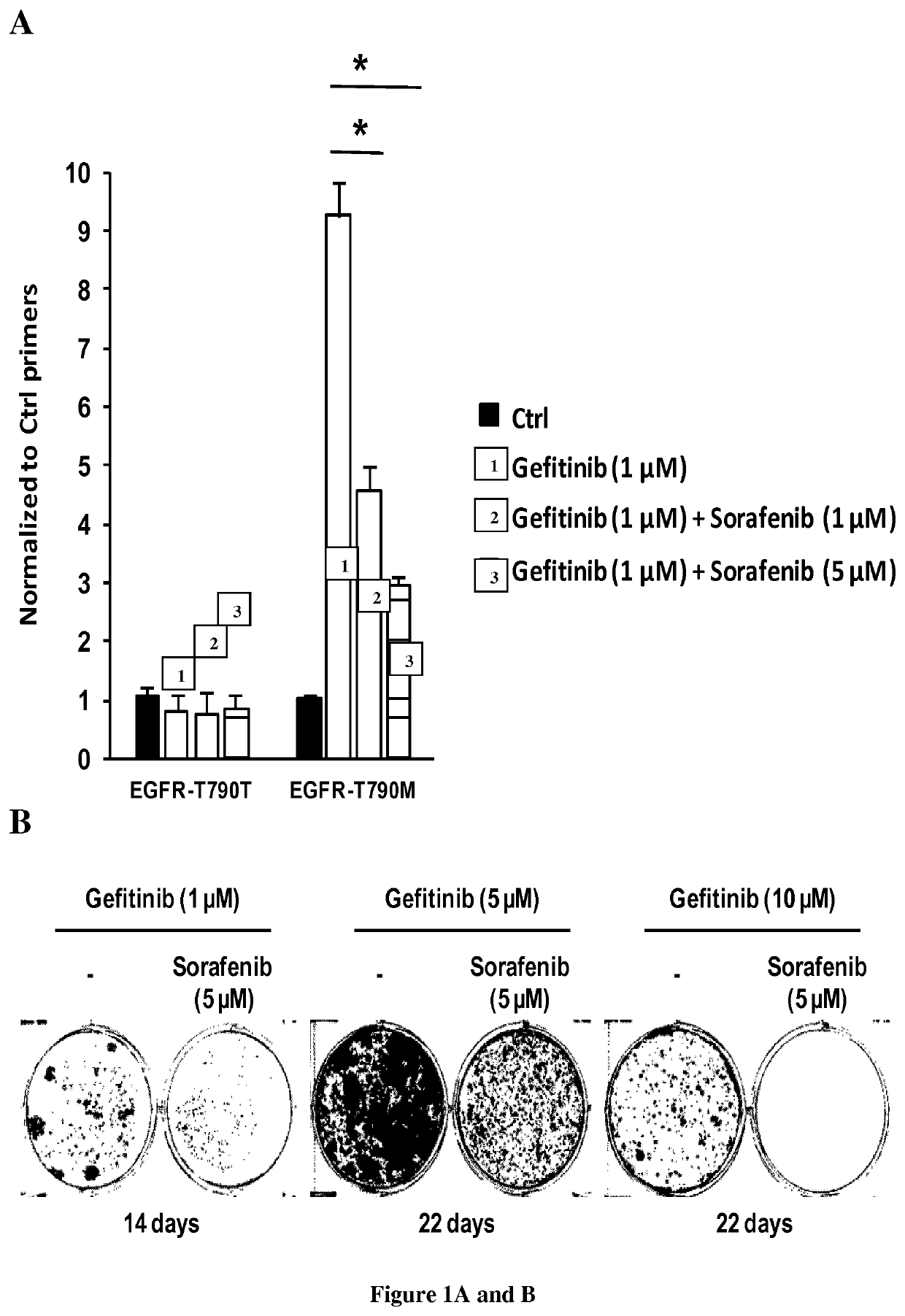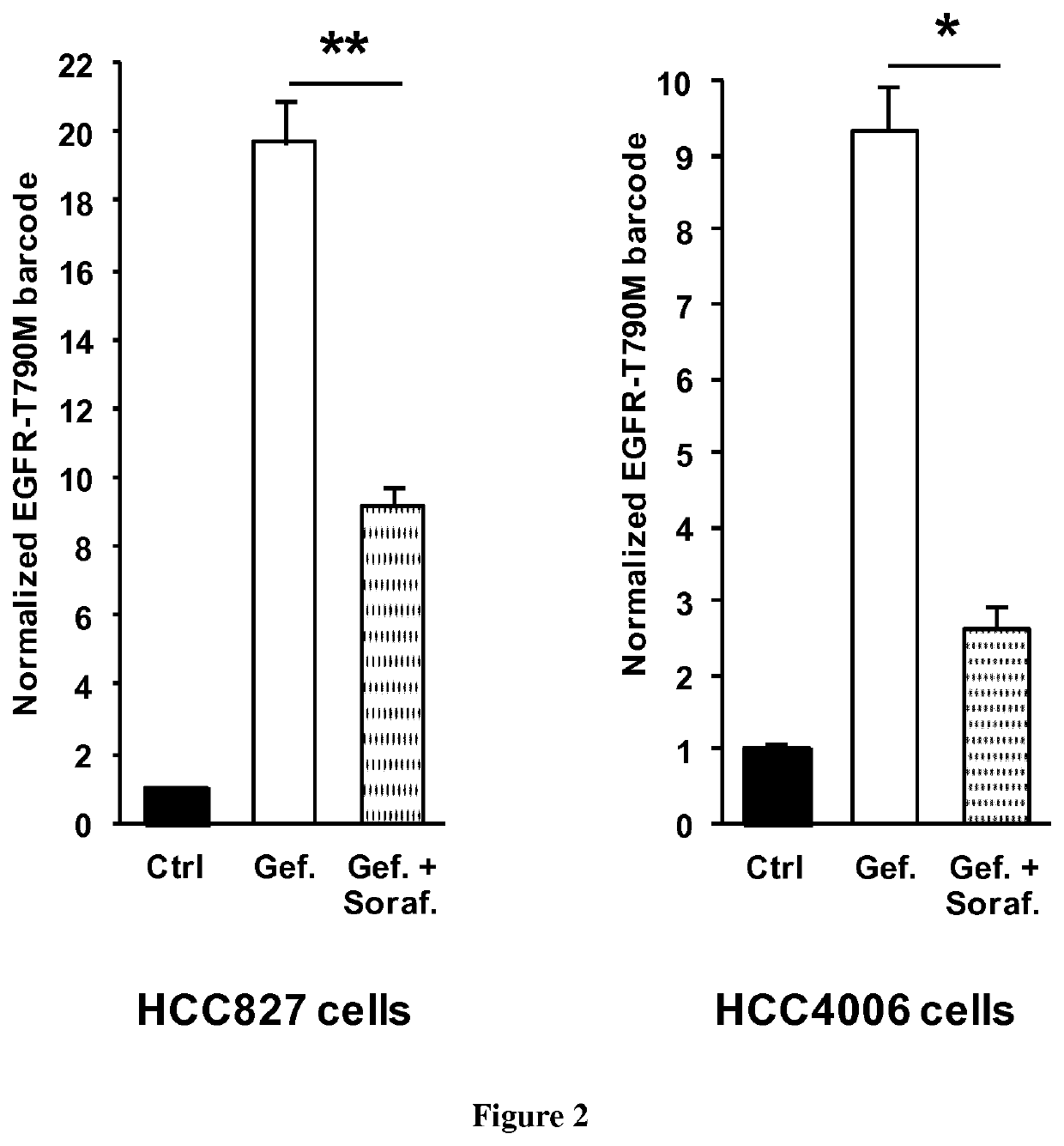Methods for preventing or treating cancer resistance to EGFR inhibition
a technology of egfr inhibitors and inhibitors, which is applied in the direction of heterocyclic compound active ingredients, drug compositions, antibody medical ingredients, etc., can solve the problems of low population response rate, ineffective or non-optimal chemotherapy, unnecessary drug toxicity and expense, etc., and achieve the effect of preventing the emergence of resistan
- Summary
- Abstract
- Description
- Claims
- Application Information
AI Technical Summary
Benefits of technology
Problems solved by technology
Method used
Image
Examples
example 1
[0081]Material & Methods
[0082]Cell Culture, Transfection and Inhibitors
[0083]NSCLC cells (PC9, HCC827 and HCC4006) were grown in Roswell Park Memorial Institute medium (Life technologies), supplemented with 10% fetal bovine serum (Life Technologies) and 0.5% penicillin / streptomycin (Life technologies). Cells were transfected with a Nucleofector II device (Lonza) using the Amaxa Nucleofector kit (Lonza) and electroporation program recommended by the manufacturer. Gefitinib, sorafenib and trametinib were purchased from Santa-Cruz Biotechnology. Osimertinib was purchased from MedChemexpress.
[0084]CRISPR Barcoding
[0085]sgRNA target sequences (Table 1) were designed using the CRISPR Design tool hosted by the Massachusetts Institute of Technology (http: / / crispr.mit.edu) to minimize potential off-target effects. Oligos encoding the targeting sequence were then annealed and ligated into the pSpCas9(BB)-2A-Puro (Ran et al., 2013) vector digested with BbsI (New England Biolabs). The sequence ...
example 2
[0099]Material & Methods
[0100]Cell Culture, Transfection and Inhibitors
[0101]PC9 cells were grown in Roswell Park Memorial Institute medium (Life technologies), supplemented with 10% fetal bovine serum (Life Technologies) and 0.5% penicillin / streptomycin (Life technologies). Cells were transfected with a Nucleofector II device (Lonza) using the Amaxa Nucleofector kit (Lonza) and electroporation program recommended by the manufacturer. Gefitinib, sorafenib and trametinib were purchased from Santa-Cruz Biotechnology. SC-1 was purchased from Sigma.
[0102]CRISPR Barcoding
[0103]sgRNA target sequences (example 1, Table 1) were designed using the CRISPR Design tool hosted by the Massachusetts Institute of Technology (http: / / crispr.mit.edu) to minimize potential off-target effects. Oligos encoding the targeting sequence were then annealed and ligated into the pSpCas9(BB)-2A-Puro (Ran et al., 2013) vector digested with BbsI (New England Biolabs). The sequence of the ssODNs (Integrated DNA Tec...
example 3
[0110]Material & Methods
[0111]Cell Culture, Transfection and Inhibitors
[0112]LIM1215 were grown in RPMI (+25 mM HEPES), supplemented with 10% fetal bovine serum (Life Technologies), Insulin (Sigma) 0.6 μg / ml, Hydrocortisone (Sigma) 1 μg / ml and 1-Thioglycerol (Sigma) 10 μM. Cells were transfected with a Nucleofector II device (Lonza) using the Amaxa Nucleofector kit (Lonza) and electroporation program recommended by the manufacturer. Sorafenib was purchased from Santa-Cruz Biotechnology. Cetuximab was purchased from Selleckchem.
[0113]CRISPR Barcoding
[0114]sgRNA target sequences (example 1, Table 1) were designed using the CRISPR Design tool hosted by the Massachusetts Institute of Technology (http: / / crispr.mit.edu) to minimize potential off-target effects. Oligos encoding the targeting sequence were then annealed and ligated into the pSpCas9(BB)-2A-Puro (Ran et al., 2013) vector digested with BbsI (New England Biolabs). The sequence of the ssODNs (Integrated DNA Technologies) used fo...
PUM
| Property | Measurement | Unit |
|---|---|---|
| Electrical resistance | aaaaa | aaaaa |
Abstract
Description
Claims
Application Information
 Login to View More
Login to View More - R&D
- Intellectual Property
- Life Sciences
- Materials
- Tech Scout
- Unparalleled Data Quality
- Higher Quality Content
- 60% Fewer Hallucinations
Browse by: Latest US Patents, China's latest patents, Technical Efficacy Thesaurus, Application Domain, Technology Topic, Popular Technical Reports.
© 2025 PatSnap. All rights reserved.Legal|Privacy policy|Modern Slavery Act Transparency Statement|Sitemap|About US| Contact US: help@patsnap.com



